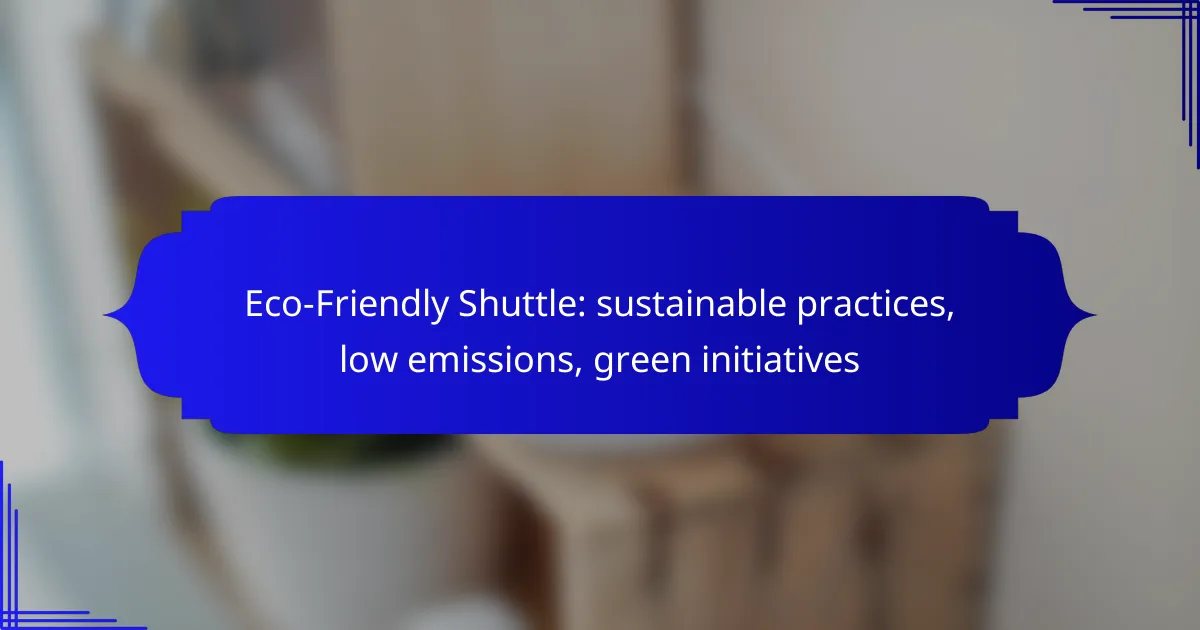Eco-friendly shuttles are revolutionizing urban transportation by utilizing electric and hybrid technologies, as well as alternative fuels, to significantly reduce emissions and enhance air quality. These services implement sustainable practices such as recycling programs and the use of eco-friendly materials, all aimed at minimizing their environmental impact. While initial costs may rise due to investments in green technologies, the long-term savings from reduced fuel and maintenance expenses make these initiatives both environmentally and economically viable.

How do eco-friendly shuttles reduce emissions in London?
Eco-friendly shuttles in London reduce emissions primarily through the use of electric and hybrid technologies, as well as alternative fuels. These initiatives not only lower greenhouse gas outputs but also contribute to improved air quality in urban areas.
Electric shuttle buses
Electric shuttle buses operate solely on electric power, eliminating tailpipe emissions entirely. They are typically charged at designated stations, and advancements in battery technology have significantly increased their range, making them suitable for urban routes.
In London, electric shuttles are becoming more common, supported by government incentives and infrastructure investments. This transition helps meet local emissions targets and enhances the sustainability of public transport.
Hybrid shuttle models
Hybrid shuttle models combine traditional internal combustion engines with electric propulsion, resulting in reduced fuel consumption and lower emissions compared to conventional buses. These vehicles can switch between power sources based on driving conditions, optimizing efficiency.
In urban settings like London, hybrids are particularly beneficial for short trips and stop-and-go traffic, where electric power can be maximized. This flexibility allows for a smoother transition towards fully electric fleets.
Use of biofuels
Biofuels, derived from organic materials, can be used in shuttle buses to replace conventional fossil fuels. This alternative reduces carbon emissions and can often be produced sustainably, contributing to a circular economy.
In London, shuttles using biofuels can help meet environmental standards while supporting local agriculture and waste management initiatives. However, the availability and cost of biofuels can vary, impacting their widespread adoption.
Regular maintenance for efficiency
Regular maintenance of eco-friendly shuttles is crucial for ensuring optimal performance and emissions reduction. Routine checks on battery systems, hybrid components, and fuel systems help maintain efficiency and extend the lifespan of the vehicles.
Operators should implement a proactive maintenance schedule that includes inspections and software updates. This practice not only enhances reliability but also ensures compliance with environmental regulations, ultimately supporting London’s green initiatives.

What sustainable practices are implemented by shuttle services?
Sustainable practices in shuttle services focus on reducing environmental impact through various initiatives. These include recycling programs, the use of eco-friendly materials in vehicles, and carbon offset initiatives that collectively aim to lower emissions and promote green transportation.
Recycling programs
Many shuttle services have adopted recycling programs to minimize waste generated during operations. This often includes recycling materials such as paper, plastics, and metals from maintenance activities and passenger waste.
Shuttle companies may partner with local recycling facilities to ensure proper disposal and recycling of materials. Implementing these programs not only helps in reducing landfill contributions but also raises awareness among passengers about the importance of recycling.
Eco-friendly materials in vehicles
Shuttle services are increasingly using eco-friendly materials in their vehicles, such as recycled plastics and sustainably sourced fabrics. These materials help reduce the carbon footprint associated with vehicle manufacturing and contribute to a more sustainable lifecycle.
Additionally, some shuttles are equipped with energy-efficient technologies, such as LED lighting and low-emission engines, which further enhance their environmental performance. Choosing vehicles that prioritize sustainability can significantly lower emissions compared to traditional options.
Carbon offset initiatives
Carbon offset initiatives allow shuttle services to compensate for their emissions by investing in environmental projects, such as reforestation or renewable energy. By calculating their carbon footprint, shuttle companies can determine the amount of offsets needed to achieve carbon neutrality.
Passengers may also be encouraged to participate in these initiatives, often through small fees added to fares that fund carbon offset projects. This collaborative effort not only mitigates the environmental impact of shuttle operations but also engages the community in sustainability efforts.

How do green initiatives impact shuttle service costs?
Green initiatives can initially increase shuttle service costs due to investments in sustainable technologies, but they often lead to long-term savings through reduced fuel expenses and maintenance costs. Understanding these dynamics is essential for operators aiming to balance eco-friendliness with financial viability.
Initial investment vs. long-term savings
Investing in eco-friendly shuttle options, such as electric or hybrid vehicles, typically requires a higher upfront cost compared to traditional vehicles. However, these investments can yield significant long-term savings through lower fuel consumption and reduced emissions-related expenses.
For instance, electric shuttles may have higher purchase prices but can save operators hundreds to thousands of dollars annually on fuel and maintenance. Over time, these savings can offset the initial investment, making green options more financially attractive.
Government incentives for green transport
Many governments offer incentives to promote green transport initiatives, which can help offset the costs of eco-friendly shuttle services. These incentives may include tax credits, grants, or subsidies aimed at encouraging the adoption of low-emission vehicles.
For example, in the United States, federal and state programs may provide substantial rebates for electric vehicle purchases, significantly lowering the effective cost for shuttle operators. Staying informed about available incentives can enhance the financial feasibility of transitioning to greener options.
Pricing strategies for eco-friendly options
Shuttle services can adopt various pricing strategies to make eco-friendly options more appealing to customers. Offering competitive pricing while highlighting the environmental benefits can attract eco-conscious riders.
Additionally, implementing tiered pricing based on vehicle type or offering discounts for frequent users can encourage the use of sustainable shuttles. For example, providing a small fare reduction for rides in electric shuttles can incentivize customers to choose greener options while maintaining profitability.

What certifications should eco-friendly shuttles have?
Eco-friendly shuttles should ideally have certifications that demonstrate their commitment to sustainable practices and low emissions. Key certifications include ISO 14001 for environmental management and LEED certification for facilities, both of which indicate adherence to rigorous environmental standards.
ISO 14001 for environmental management
ISO 14001 is an international standard that outlines the criteria for an effective environmental management system (EMS). It helps organizations improve their environmental performance through more efficient use of resources and reduction of waste. For eco-friendly shuttles, obtaining this certification means they are actively managing their environmental responsibilities.
To achieve ISO 14001 certification, shuttles must implement a systematic approach to environmental management, including setting objectives, monitoring performance, and continuously improving their practices. This can involve regular audits and stakeholder engagement to ensure compliance and effectiveness.
LEED certification for facilities
LEED (Leadership in Energy and Environmental Design) certification is a globally recognized symbol of sustainability achievement in building design and operation. For eco-friendly shuttle facilities, this certification signifies that the buildings meet high standards for energy efficiency, water usage, and indoor environmental quality.
To qualify for LEED certification, shuttle facilities must meet specific criteria across various categories, including sustainable site development, water savings, energy efficiency, and materials selection. This can involve using renewable energy sources, efficient water fixtures, and sustainable building materials, all contributing to a lower environmental impact.

How can passengers contribute to sustainability?
Passengers can significantly contribute to sustainability by making conscious choices regarding their transport options and engaging in carbon offset programs. Simple actions can lead to reduced emissions and a positive impact on the environment.
Choosing eco-friendly transport options
Selecting eco-friendly transport options is crucial for minimizing carbon footprints. Passengers should consider using public transportation, carpooling, or electric shuttle services that prioritize low emissions. These alternatives often use less energy per passenger compared to traditional vehicles.
When planning a trip, look for shuttle services that are certified green or have a commitment to sustainability. For example, some companies utilize electric or hybrid vehicles, which can reduce emissions by a significant margin compared to gasoline-powered shuttles.
Participating in carbon offset programs
Engaging in carbon offset programs allows passengers to counterbalance their travel emissions. By purchasing carbon credits, individuals can support projects that reduce greenhouse gases, such as renewable energy initiatives or reforestation efforts. This practice helps to neutralize the environmental impact of their travel.
Many shuttle services offer options to contribute to carbon offset programs at the time of booking. Passengers should inquire about these opportunities and consider adding a small fee to their fare, which can lead to substantial environmental benefits over time.

What are the future trends in eco-friendly shuttle services?
Future trends in eco-friendly shuttle services focus on integrating advanced technologies and renewable energy sources to reduce emissions and enhance sustainability. These developments aim to create efficient, low-impact transportation options that meet growing environmental standards.
Integration of autonomous electric shuttles
Autonomous electric shuttles represent a significant trend in eco-friendly transportation, combining low emissions with advanced technology. These shuttles operate without human drivers, utilizing sensors and software to navigate efficiently, which can lead to reduced energy consumption and lower operational costs.
As cities adopt these vehicles, they can expect to see improvements in traffic flow and safety. For instance, autonomous shuttles can optimize routes in real-time, minimizing idle time and maximizing passenger capacity. Local governments may need to establish regulations to ensure safety and efficiency in deployment.
Expansion of renewable energy sources
Renewable energy sources are increasingly being integrated into eco-friendly shuttle services, providing a sustainable power supply for electric vehicles. Solar, wind, and other renewable energies can significantly reduce the carbon footprint associated with traditional fuel sources.
Shuttle services can benefit from partnerships with renewable energy providers to power their fleets. For example, charging stations powered by solar panels can be installed at shuttle stops, ensuring that the energy used is clean and sustainable. This shift not only supports environmental goals but can also lead to cost savings in the long run.
